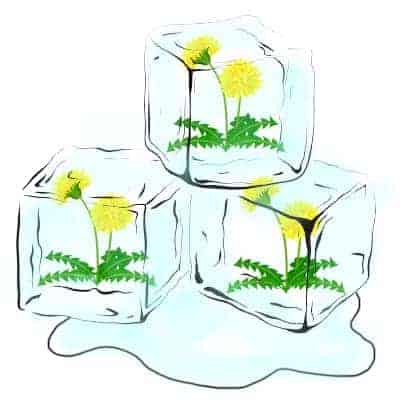
Shop bought salad leaves and vegetables are okay for tortoises, especially the organic stuff, but you really can’t beat home grown fresh weeds and flowers if you can get them. The trouble is you might not be able to grow enough of them, or grow them all year round.
If you’ve ever wondered if there are ways to store your produce for longer, so that you’ve got a steady supply to keep feeding your tortoise when the plants and weeds aren’t thriving, there are a couple of things you can try. Freezing, refrigerating, or drying out plants are all options, although of course nothing beats fresh produce.

Likewise if you want your friends and family to help out and pick weeds from their gardens/yards, then these same methods might help them to store what they’ve picked for you before you see them.
Growing Weeds
Before you consider extending the shelf life of your plants and weeds to see your tortoise through winter, you might want to take your strategy for growing and harvesting them beyond simply hunting for them in your garden, to actually having a dedicated growing set up.
Obviously the advantage to growing weeds under controlled conditions is that you don’t need to worry about pollutants in the atmosphere, animal urine , pesticides or any other pollutants you might find on weeds collected from the side of a road or your local park. If you can grow them in a controlled environment, it’s definitely a better strategy.
If you’re not particularly green fingered, don’t worry, the advantage of growing weeds like dandelions is that you shouldn’t have too much trouble doing it – weeds are after all notorious for growing where you don’t want them to, so it shouldn’t be too difficult to actually encourage them to grow!
There are several methods people use to grow weeds, from a simple plant pot on the window sill that you give a little water to very day, to a dedicated tray in your greenhouse, to simply planting additional weeds in your tortoise’s enclosure either outdoors, or indoors within a dedicated part of the substrate in your tortoise table.
Outdoor cultivation is a fine strategy, although of course you won’t have as much control over the quality of the product you produce in the winter.
Wherever you choose to grow your weeds, the basic strategy is the same:
- Use shop bought packets of seeds
- Use low quality soil – honest! Weeds thrive in the most inhospitable areas possible, so using the worst quality soil you can is actually of benefit to your weed growing strategy
- Just like all plants weeds require soil, light and water to grow. So if you’re growing your weeds indoors be sure to place the pot or container on a window sill that gets plenty of sunlight, and don’t forget to give the seeds a little water everyday. Just don’t over do it, or you might drown them.
Freezing Weeds
Once you’ve carefully cultivated your weeds you’ll either use them straight away, or look to preserve them for future use.
One such method that seems logical enough is to freeze surplus weeds and plants and defrost them at a later date.
Sadly the reality of this practice isn’t nearly as neat and effective as I would like. Most people who’ve attempted to freeze plants in this way note that everything seems to go well up to the point of defrosting, after which you’re left with a gloopy sludge rather than a perfectly preserved plant ready for consumption.
The rumour goes that to prevent this you should place the leaves in a container (perhaps a freezer bag) without any additional moisture, therefore if you wash them beforehand try as best you can to dry them of excess water before putting them in the bag. Sprinkling a decent amount of calcium carbonate (otherwise known as limestone flour) over the weeds and leaves will keep them dry and prevent them turning to mush when you defrost them.
Given this process is a bit fiddly, you probably won’t want to freeze huge quantities of plants and weeds in this manner. What it does do however is provide an additional ‘garnish’ to less nutritious shop bought diet during the winter months.
Drying Weeds
A more traditional/tried and tested option to preserve weeds and flowers is to dry them out. Whilst there’s debate over the efficacy of drying as a means to preserve the nutritional value of plant life, again if used as a means to add variety to other foods, dry plants provide the ideal complement to a tortoise’s diet.
If you’re not up to the faff of putting plants in you airing cupboard you can of course buy ready made boxes of them, which again I would use to similar effect, especially for juveniles.
Refrigerating Weeds
For short term preservation let’s not forget good old refrigeration as a means to keep foods fresh for longer.
I find keeping plants and weeds in the fridge will keep them fresh for about a week, which is sometimes all you need if you need to work your way through a backlog of produce.



